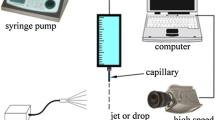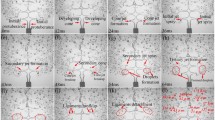Abstract
The liquid emitting from capillary subjected to a high electric voltage could be dispersed in different ways depending on applied potential and flow rate. The electro-spraying of deionized water was experimentally studied adopting the high-speed camera under different operating parameters. The time resolved images and evolution of drop or/and jet initiation, pulsation, deformation, and separation from capillary tip or meniscus were captured and analyzed. The known electro-spraying modes were identified according to the geometrical forms of meniscus, jet, or/and drop. A spherical droplet with diameter larger than the outer diameter of capillary could be generated in dripping mode at low potential, while a spherical droplet with diameter smaller than outer diameter of capillary could be observed in micro-dripping mode with relative high potential. Spindle-like droplet could be found in spindle mode and usually further disperse into a few of drops with different size for larger flow rate. In the range of applied potential and flow rate, oscillating jet and simple jet could be found, where a long jet could be elongated by electric stresses and further break up into finer drops with highly charged drops. In addition, the operating parameters and drop sizes for different modes are also discussed. Meanwhile, the spraying modes with double capillaries were also observed and discussed.
Similar content being viewed by others
Change history
05 February 2022
A Correction to this paper has been published: https://doi.org/10.1007/s42757-022-0132-z
References
Böttner, C.-U., Sommerfeld, M. 2002. Numerical calculation of electrostatic powder painting using the Euler/Lagrange approach. Powder Technol, 125: 206–216.
Choi, J., Kim, Y.-J., Lee, S., Son, S. U., Ko, H. S., Nguyen, V. D., Byun, D. 2008. Drop-on-demand printing of conductive ink by electrostatic field induced inkjet head. Appl Phys Lett, 93: 193508.
Cloupeau, M., Prunet-Foch, B. 1994. Electrohydrodynamic spraying functioning modes: a critical review. J Aerosol Sci, 25: 1021–1036.
Deng, W., Klemic, J. F., Li, X., Reed, M. A., Gomez, A. 2006. Increase of electrospray throughput using multiplexed microfabricated sources for the scalable generation of monodisperse droplets. J Aerosol Sci, 37: 696–714.
Fenn, J. B., Mann, M., Meng, C. K., Wong, S. F., Whitehouse, C. M. 1989. Electrospray ionization for mass spectrometry of large biomolecules. Science, 246: 64–71.
Gan, Y., Luo, Z., Cheng, Y., Xu, J. 2015. The electro-spraying characteristics of ethanol for application in a small-scale combustor under combined electric field. Appl Therm Eng, 87: 595–604.
Gan, Y., Zhang, X., Li, H., Tong, Y., Zhang, Y., Shi, Y., Yang, Z. 2016. Effect of a ring electrode on the cone-jet characteristics of ethanol in small-scale electro-spraying combustors. J Aerosol Sci, 98: 15–29.
Gañán-Calvo, A. M. 1997. Cone-jet analytical extension of taylor’s electrostatic solution and the asymptotic universal scaling laws in electrospraying. Phys Rev Lett, 79: 217–220.
Gañán-Calvo, A. M., Davila, J., Barrero, A. 1997. Current and droplet size in the electrospraying of liquids. Scaling laws. J Aerosol Sci, 28: 249–275.
Gañán-Calvo, A. M., Lasheras, J. C., Davila, J., Barrero, A. 1994. The electrostatic spray emitted from an electrified conical meniscus. J Aerosol Sci, 25: 1121–1142.
Gañán-Calvo, A. M., Lopez-Herrera, J. M., Herrada, M. A., Ramos, A., Montanero, J. M. 2018. Review on the physics of electrospray: From electrokinetics to the operating conditions of single and coaxial Taylor cone-jets, and AC electrospray. J Aerosol Sci, 125: 32–56.
Gañán-Calvo, A. M., Rebollo-Munoz, N., Montanero, J. M. 2013. Physical symmetries and scaling laws for the minimum or natural rate of flow and droplet size ejected by Taylor cone-jets. New J Phys, 15: 033035.
Gaunt, L. F., Hughes, J. F., Harrison, N. M. 2003. Removal of domestic airborne dust particles by naturally charged liquid sprays. J Electrostat, 58: 159–169.
Hayati, I., Bailey, A. I., Tadros, Th. F. 1987a. Investigations into the mechanisms of electrohydrodynamic spraying of liquids: I. Effect of electric field and the environment on pendant drops and factors affecting the formation of stable jets and atomization. J Colloid Interf Sci, 117: 205–221.
Hayati, I., Bailey, A., Tadros, T. 1987b. Investigations into the mechanism of electrohydrodynamic spraying of liquids. J Colloid Interf Sci, 117: 222–230.
Jaworek, A., Krupa, A. 1999. Classification of the modes of EHD spraying. J Aerosol Sci, 30: 873–893.
Jaworek, A., Krupa, A., Sobczyk, A. T., Marchewicz, A., Szudyga, M., Antes, T., Balachandran, W., di Natale, F., Carotenuto, C. 2013. Submicron particles removal by charged sprays. Fundamentals. J Electrostat, 71: 345–350.
Jaworek, A., Sobczyk, A. T. 2008. Electrospraying route to nanotechnology: An overview. J Electrostat, 66: 197–219.
Jayasinghe, S. N., Edirisinghe, M. J. 2002. Effect of viscosity on the size of relics produced by electrostatic atomization. J Aerosol Sci, 33: 1379–1388.
Juraschek, R., Röllgen, F. W. 1998. Pulsation phenomena during electrospray ionization. Int J Mass Spectrom, 177: 1–15.
Karbalaei, A., Cho, H. J. 2020. Passive mixing rate of trapped squeezed nanodroplets—A time scale analysis. Exp Comput Multiphase Flow, 2: 135–141.
Kelly, A. J. 1994. On the statistical, quantum and practical mechanics of electrostatic atomization. J Aerosol Sci, 25: 1159–1177.
Kim, H. H., Kim, J. H., Ogata, A. 2011. Time-resolved high-speed camera observation of electrospray. J Aerosol Sci, 42: 249–263.
Kim, H. H., Teramoto, Y., Negishi, N., Ogata, A., Kim, J. H., Pongrac, B., MacHala, Z., Ganan-Calvo, A. M. 2014. Polarity effect on the electrohydrodynamic (EHD) spray of water. J Aerosol Sci, 76: 98–114.
Kim, J. H., Lee, H. S., Kim, H. H., Ogata, A. 2010. Electrospray with electrostatic precipitator enhances fine particles collection efficiency. J Electrostat, 68: 305–310.
Lastow, O., Balachandran, W. 2007. Novel low voltage EHD spray nozzle for atomization of water in the cone jet mode. J Electrostat, 65: 490–499.
Law, S. E. 1983. Electrostatic pesticide spraying: Concepts and practice. IEEE T Ind Appl, IA-19: 160-168.
Law, S. E. 1989. Electrical interactions occurring at electrostatic spraying targets. J Electrostat, 23: 145–156.
Lee, M. W., Kim, N. Y., Yoon, S. S. 2013. On pinchoff behavior of electrified droplets. J Aerosol Sci, 57: 114–124.
Li, J. L., Tok, A. 2008. Electrospraying of water in the cone-jet mode in air at atmospheric pressure. Int J Mass Spectrom, 272: 199–203.
MacHala, Z., Chladekova, L., Pelach, M. 2010. Plasma agents in bio-decontamination by dc discharges in atmospheric air. J Phys D: Appl Phys, 43: 222001.
Martinez-Sanchez, M., Pollard, J. E. 1998. Spacecraft electric propulsion-an overview. J Propul Power, 14: 688–699.
Maski, D., Durairaj, D. 2010. Effects of electrode voltage, liquid flow rate, and liquid properties on spray chargeability of an air-assisted electrostatic-induction spray-charging system. J Electrostat, 68: 152–158.
Matthews, G. A. 1989. Elestrostatic spraying of pesticides: a review. Crop Protect, 8: 3–15.
Miao, P., Balachandran, W., Xiao, P. 2002. Formation of ceramic thin films using electrospray in cone-jet mode. IEEE T Ind Appl, 38: 50–56.
Pongrác, B., Kim, H. H., Negishi, N., MacHala, Z. 2014. Influence of water conductivity on particular electrospray modes with dc corona discharge—optical visualization approach. Eur Phys J D, 68: 224.
Rosell-Llompart, J., Grifoll, J., Loscertales, I. G. 2018. Electrosprays in the cone-jet mode: From Taylor cone formation to spray development. J Aerosol Sci, 125: 2–31.
Sato, M., Kudo, N., Saito, N. 1998. Surface tension reduction of liquid by applied electric field using vibrating jet method. IEEE T Ind Appl, 34: 294–300.
Tang, K., Gomez, A. 1995. Generation of monodisperse water droplets from electrosprays in a corona-assisted cone-jet mode. J Colloid Interf Sci, 175: 326–332.
Tang, L., Kebarle, P. 1991. Effect of the conductivity of the electrosprayed solution on the electrospray current. Factors determining analyte sensitivity in electrospray mass spectrometry. Anal Chem, 63: 2709–2715.
Waits, C. M., Hanrahan, B., Lee, I. 2010. Multiplexed electrospray scaling for liquid fuel injection. J Micromechan Microeng, 20: 104010.
Wang, Z., Dong, K., Tian, L., Wang, J., Tu, J. 2018c. Numerical study on coalescence behavior of suspended drop pair in viscous liquid under uniform electric field. AIP Adv, 8: 085215.
Wang, Z., Li, R., Tian, L., Xia, L., Zhan, S., Wang, J., Tu, J. 2019. Visualization of periodic emission of drops with micro-dripping mode in electrohydrodynamic (EHD) atomization. Exp Therm Fluid Sci, 105: 307–315.
Wang, Z., Mitrašinovic, A., Wen, J. 2012. Investigation on electrostatical breakup of bio-oil droplets. Energies, 5: 4323–4339.
Wang, Z., Tian, L., Xia, L., Dong, J., Wang, J., Tu, J. 2018b. Experimental study on repetition frequency of drop/jet movement in electrospraying of deionized water. Aerosol Air Qual Res, 18: 301–313.
Wang, Z., Xia, L., Tian, L., Wang, J., Zhan, S., Huo, Y., Tu, J. 2018a. Natural periodicity of electrohydrodynamic spraying in ethanol. J Aerosol Sci, 117: 127–138.
Wang, Z., Xia, L., Zhan, S. 2017. Experimental study on electrohydrodynamics (EHD) spraying of ethanol with double-capillary. Appl Therm Eng, 120: 474–483.
Yogi, O., Kawakami, T., Mizuno, A. 2006. Properties of droplet formation made by cone jet using a novel capillary with an external electrode. J Electrostat, 64: 634–638.
Zeleny, J. 1914. The electrical discharge from liquid points, and a hydrostatic method of measuring the electric intensity at their surfaces. Phys Rev, 3: 69–91.
Zeleny, J. 1917. Instability of electrified liquid surfaces. Phys Rev, 10: 1–8.
Zhang, J., He, H., Huang, G. 2018. Dynamic characteristics of charged droplets in an electrostatic spraying process with twin capillaries. Chinese J Chem Eng, 26: 2403–2411.
Zhang, X., Basaran, O. A. 1996. Dynamics of drop formation from a capillary in the presence of an electric field. J Fluid Mechan, 326: 239–263.
Acknowledgements
National Natural Science Foundation of China (No. 51106064), Natural Science Foundation of Jiangsu Province, China (No. BK20171301), China Postdoctoral Science Foundation (No. 2018M635545), and a project supported by Jiangsu University for NSFC (No. FCJJ2015001) are acknowledged.
Author information
Authors and Affiliations
Corresponding author
Rights and permissions
About this article
Cite this article
Wang, Q., Wang, Z., Jiang, Y. et al. Experimental study of electro-spraying modes of deionized water in atmospheric environment. Exp. Comput. Multiph. Flow 3, 38–46 (2021). https://doi.org/10.1007/s42757-019-0057-3
Received:
Revised:
Accepted:
Published:
Issue Date:
DOI: https://doi.org/10.1007/s42757-019-0057-3




